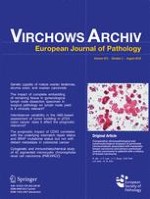Erschienen in:

07.05.2018 | Brief Report
β-catenin (CTNNB1) mutation and LEF1 expression in sinonasal glomangiopericytoma (sinonasal-type hemangiopericytoma)
verfasst von:
Yuka Suzuki, Shu Ichihara, Tomonori Kawasaki, Hiroyuki Yanai, Satoshi Kitagawa, Yoshie Shimoyama, Shigeo Nakamura, Masato Nakaguro
Erschienen in:
Virchows Archiv
|
Ausgabe 2/2018
Einloggen, um Zugang zu erhalten
Abstract
Sinonasal glomangiopericytoma (SN-GPC) is an uncommon mesenchymal tumor with myoid differentiation. Recently, mutations in exon 3 of the gene coding for β-catenin (CTNNB1) and its nuclear expression were discovered in SN-GPC. β-catenin protein is a key regulatory molecule of the canonical Wnt signaling pathway. The expression of β-catenin target proteins is not well characterized in SN-GPC. We examined three SN-GPCs by immunohistochemistry and CTNNB1 mutation analysis. All cases expressed nuclear β-catenin. We identified CTNNB1 exon 3 mutations in two analyzable cases. Lymphoid enhancer-binding factor 1 (LEF1), a protein downstream from β-catenin, was also expressed in all cases. Our results further characterized the activation of the Wnt signaling pathway caused by CTNNB1 exon 3 mutation and suggest the utility of LEF1 immunohistochemistry in the differential diagnosis of SN-GPC.